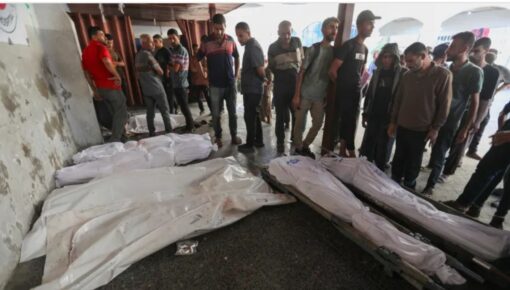Israel’s latest assault on Gaza has killed more than 60 Palestinians since dawn, with United Nations officials accusing the Israeli military of inflicting terror on a population already devastated by nearly two years of continuous bombardment.
The renewed strikes come as a civilian flotilla attempting to break the sea blockade of Gaza reported explosions, drone harassment, and communications jamming off the coast, raising fears of another violent confrontation on the high seas.
Gaza’s Ministry of Health reported that the death toll from the overnight and morning bombardments continues to climb as rescue workers struggle to reach collapsed buildings.

In Gaza City, already reduced to rubble from previous attacks, residents described scenes of panic as entire neighborhoods were emptied in minutes under the roar of jet fighters and artillery. Tens of thousands fled once again, seeking shelter in hospitals, schools, and makeshift camps that are themselves targets of military strikes.
The UN issued a strongly worded statement, warning that Israel’s conduct amounted to “inflicting terror on the civilian population of Gaza City and forcing mass displacement.” International observers say the scale of the attacks represents one of the deadliest days since the war began following the Hamas-led assault on southern Israel on October 7, 2023.
That initial attack killed 1,139 people and saw about 200 captives taken into Gaza, sparking an Israeli campaign that has since killed at least 65,382 Palestinians and wounded 166,985, according to local authorities. Thousands more remain unaccounted for under the rubble.
While Israel insists it is pursuing Hamas, humanitarian groups argue the tactics amount to collective punishment. The UN, Amnesty International, and other rights bodies have accused Israel of war crimes, with a recent inquiry concluding that its campaign meets the definition of genocide.
The relentless pace of the airstrikes has left many neighborhoods uninhabitable, with infrastructure systematically dismantled and food, water, and electricity cut off in what aid workers describe as a deliberate strategy of starvation and displacement. no in
At sea, the Global Sumud Flotilla reported that its boats came under electronic interference and drone surveillance overnight. Activists on board said they heard explosions nearby and suspected Israeli forces were attempting to intimidate them before they reached Gaza’s waters.
The flotilla, made up of civilian vessels carrying humanitarian supplies, has vowed to challenge Israel’s blockade despite repeated threats from the Israeli navy that it will “take the necessary measures” to stop them. Organizers compared the tactics against them to piracy, while Israel insists the blockade is essential to prevent weapons from entering Gaza.
The flotilla’s presence recalls previous attempts to break the siege, most notably the 2010 Mavi Marmara incident in which Israeli commandos killed nine activists on a Turkish vessel.
Analysts warn that a repeat of such violence could further inflame global outrage against Israel, which is already facing unprecedented diplomatic isolation. More than 150 countries now recognize Palestine, and European governments are debating sanctions and arms embargoes in response to the mounting death toll.
Despite calls from world leaders for an immediate ceasefire, Israel’s government has pressed ahead with what it describes as a fight for its survival.
Prime Minister Benjamin Netanyahu vowed that operations would continue “until Hamas is eradicated,” dismissing international condemnation as politically motivated. Yet critics argue the war has long ceased to be about Hamas, pointing to the sheer scale of destruction and the explicit statements from some Israeli officials about permanently depopulating Gaza and reshaping the demographics of the region.
Inside Gaza, survivors describe a reality that few can imagine. Families displaced half a dozen times now live in tents pitched in the ruins of their homes. Hospitals, already overwhelmed by casualties, are collapsing under shortages of fuel, medicine, and staff.
Aid convoys are regularly blocked or bombed, with the UN accusing Israel of weaponizing hunger. International relief agencies have warned of famine conditions, particularly among children, yet supplies continue to be throttled.
The rising toll and humanitarian collapse have amplified tensions abroad. In Washington, President Trump declared during his United Nations address that the war “must stop immediately,” but his administration has offered no concrete policy shift to rein in Israel.
Critics argue that despite the rhetoric, U.S. military support and diplomatic cover remain intact. European leaders, meanwhile, are under growing domestic pressure to act, with street protests demanding an end to arms sales and a boycott of Israeli goods.
For Palestinians, the sense of abandonment deepens daily. With Gaza effectively sealed off and the West Bank also under intensifying violence from Israeli settlers and troops, prospects for peace seem more distant than ever.
The Palestinian Authority, weakened and discredited, has failed to mount a meaningful response, leaving Hamas and other factions as the only visible resistance despite Israel’s stated goal of destroying them.
The Global Sumud Flotilla insists its mission is peaceful, with ships carrying food, medicine, and symbolic messages of solidarity. Yet Israel views any attempt to breach the blockade as a threat, and naval commanders have been ordered to stop the convoy by any means necessary.
Observers warn that an assault on the flotilla could trigger a wider diplomatic crisis, especially if international activists are injured or killed. Already, footage of drones circling overhead and passengers scrambling to maintain communications has circulated widely online, fueling outrage.
In Gaza, the devastation continues to mount. Families dig through rubble with bare hands, often recovering only body parts of loved ones. Cemeteries are overflowing, and mass graves have become the grim norm.
Children, who make up half of Gaza’s population, are disproportionately affected, with thousands killed and many more orphaned or permanently injured. UN officials describe the psychological scars as generational, warning that an entire society is being dismantled in plain view of the world.
Yet despite the catastrophe, there are few signs of restraint from Israel. Instead, military planners appear to be escalating both air and ground operations.
Analysts suggest that Israel hopes to break Palestinian resistance by sheer force, banking on international fatigue and divisions among global powers. However, such tactics risk backfiring by hardening Palestinian resolve and deepening Israel’s isolation.
As the bombardment intensifies, calls for accountability grow louder. The International Criminal Court has been urged to accelerate investigations into alleged war crimes, while legal scholars argue that governments continuing to arm Israel could themselves face complicity charges.

Civil society movements are pushing for sanctions, divestments, and boycotts, echoing the anti-apartheid campaigns that once targeted South Africa.
For the people of Gaza, however, these international debates offer little immediate relief. Each day brings new casualties, new funerals, and new displacements.
What remains of Gaza City has become a ghost town punctuated by the sounds of bombs and the cries of the grieving. In refugee camps, children scrawl names of lost relatives on the walls, while parents whisper that the world has chosen to look away.
The war, now approaching its second year, shows no sign of abating. Israel’s leadership insists on pressing forward, the flotilla sails into danger, and the United Nations issues condemnation after condemnation with little effect.
The latest wave of deaths and the looming naval confrontation illustrate how the Gaza Israeli bombardment is not just a military campaign but a grinding war of attrition that is reshaping the entire region.
Read more: swiftreportnow


